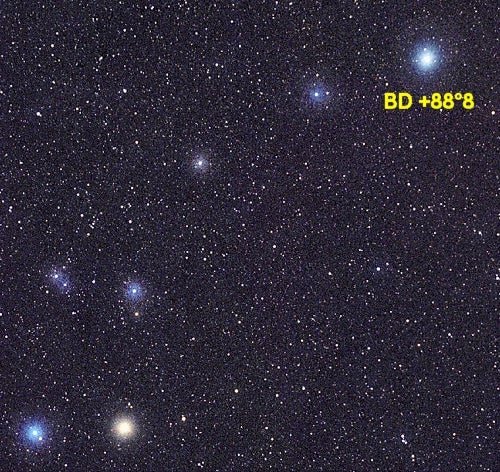First, let’s look into how star names originally were documented.
A few months ago, I received an e-mail from New York reader Christine Unger, asking, “How is it possible to have the same star in two different constellations?” She was referring to a map in my October 2004 column (“Gettin’ shapes”) showing two stars labeled “Alpha” — one in Triangulum and the other in Andromeda. Well, Christine, it wasn’t a typo.
The brightest stars have proper names, often dating back to antiquity. Tonight, we can gaze skyward at Sirius and Procyon (named by the ancient Greeks), Betelgeuse and Aldebaran (Arabic names). For anyone interested in the origin of star names, I highly recommend Star Names: Their Lore and Meaning, by Richard Hinckley Allen (Dover Publications, New York, 1963). This classic work was first published more than a century ago and is one of my favorite astronomy references.
Credit German astronomer Johann Bayer for the “Alphas” in Triangulum and Andromeda. In 1603, he published his landmark celestial atlas, Uranometria, in which the stars in each constellation usually were assigned letters from the Greek alphabet. Alpha (α) went to the brightest star, Beta (β) to the next brightest, and so on through Omega (ω).
A star’s complete Bayer designation includes its Greek letter, followed by the genitive form of its parent constellation. The two “Alphas” Christine saw on the chart are properly called Alpha Trianguli and Alpha Andromedae.
What happens in constellations whose naked-eye stars outnumber the 24 letters of the Greek alphabet? In the early 18th century, English astronomer John Flamsteed compiled a catalog of stars — Atlas Coelestis. This catalog, published in 1725 after Flamsteed’s death, is one of the first atlases that uses equatorial coordinates (see “The golden age of star maps,” December 2004). A later French edition of this catalog assigned numbers to the stars in the original Atlas Coelestis.
You may be wondering about those companies that allow you to name a star for a fee. Beware: The star name you pay for is not recognized by the International Astronomical Union — the organization that, among other things, officially names celestial bodies. My suggestion? Instead of spending your money on just one star, invest in binoculars or a telescope. Then, you’ll “own” all the stars you could ask for!
Now for the answer to our trivia question. Our mystery star is Alpha Ursae Minoris, better known as Polaris, the North Star. BD +88°8, HD 8890, BS 424, and SAO 308 are names for Polaris from various star catalogs, while Struve 93 and ADS 1477 are its designations in double-star catalogs.
As a double star, Polaris offers an observing challenge to any small telescope owner — especially for the standard 2.4-inch refractor so many of us own. Often, a double star is hard to “split” because its member stars are close together. Not so with Polaris. Its components are separated by 18″ — a vast gulf as double stars go.
But its companion is a full 7 magnitudes (630 times) fainter than the main star and often is hidden by Polaris’ glare. Wait for an evening when the stars are shining steadily (good “seeing” conditions), and use a magnification of at least 100x to attempt to split these two stars.
“That which we call a rose, by any other name would smell as sweet.” I doubt William Shakespeare had astronomical objects in mind when he penned these lines, but his words certainly can apply to star names. Whether you refer to it as BD +88°8, HD 8890, BS 424, SAO 308, Struve 93, ADS 1477, Polaris, or Alpha Ursae Minoris, our noble North Star is a worthy target for your telescope.
Questions, comments, or suggestions? E-mail me through this web-based form.
Next month: March Madness brings the Moon, Mercury, and Messier Marathon 2005. Clear Skies.











